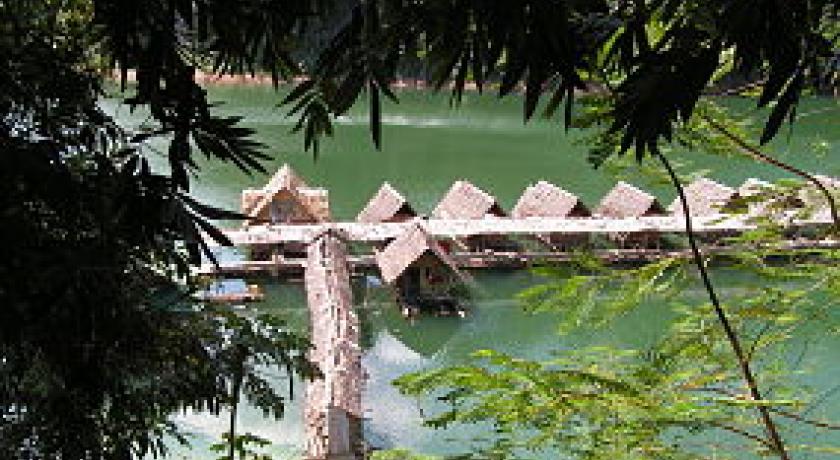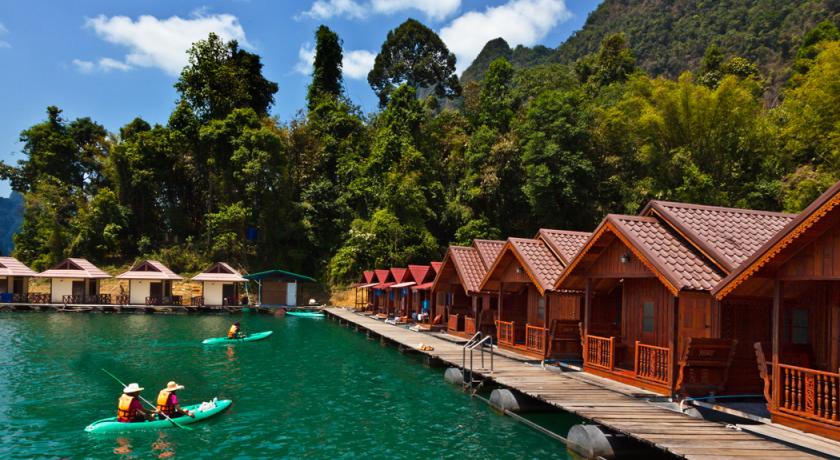Guide description
Khao Sok National Park (Thai: เขาสก) is in Surat Thani Province, Thailand. Its area is 739 km², and it includes the 165 square kilometer Cheow Lan Lake contained by the Ratchaprapha Dam. The park is the largest area of virgin forest in southern Thailand and is a remnant of rain forest which is said by some to be older and more diverse than the Amazon rain forest.
Geography
Beautiful sandstone and mudstone rocks rise about 300–600 m above sea level. The park is traversed by a limestone mountain range from north to south with a high point of 950 m. This mountain range is hit by monsoon rain coming from both the Gulf of Thailand and the Andaman Sea, which makes it among Thailand's wettest regions with an annual rain fall of approximately 3,500 mm. Heavy rainfall and falling leaves led to the erosion of the limestone rocks and created the significant karst (stunning rock) formations seen today.
Flora
Bamboo holds topsoil very tenaciously, preventing soil erosion on hillsides and riverbanks. With more than 1,500 species, bamboo is the oldest grass in the world, dating back nearly 60 million years. Liana trees grow rapidly wrapping around any vertical or horizontal support base such as takian or "rain trees". Thus it is dangerous to simply cut a tree in the jungle because it can pull connected liana vines with it creating a cascade of damage. Buttress roots are enlarged root bases mostly of trees that grow above the upper canopy. The theory about these roots is that they either developed in order to be more grounded in storms and rain or that they spread out on the ground in order to get more nutrients.
Many kinds of wild fruit can be found around the national park and serve as sustenance for animals. Among those fruits are wild jackfruit, mangosteen, durian, rambutan, jujube, pomelo, and wild bananas. Wild pepper and ginger are not uncommon. Khao Sok National Park is perhaps most famous for the bua phut (Rafflesia kerrii) flower.
Wildlife
The park is estimated to contain over five percent of the world's species of wild mammals include Malayan tapir, Asian elephant, tiger, sambadeer, bear, guar, banteng, serow, wild boar, pig-tailed macaque, langur, white handed gibbons, squirrel, muntjak, mouse deer, barking deer.
Natural History
This area is estimated to be over 160 million years old, built through tectonic movements, climate changes, erosions and sediment accumulations. Approximately 300 million years ago, shallow water and warm temperatures in this region led to the creation of a huge coral reef. Estimated to be 5 times as big as the Great Barrier Reef in Australia, it originally stretched from China all the way Borneo. Due to the collision of the Indian and Eurasian plate 0-66 million years ago, the Himalayas were formed, and what is now Thailand shifted dramatically near the continental divide and the limestone rocks were forced upward creating the dramatic limestone "karsts" for which the region is known today. Finally, melting ice established the river-rich landscape as well as dozens of waterfalls around the national park
Human History
The first migrants to Thailand migrated during the Ice Age from Borneo it is thought around 37000 BCE. The first accounts of people living in Khao Sok were found in the 1800s. In 1944 the inhabitants of this region were stricken by a deadly epidemic. A large number of the villagers died while the few survivors escaped from the area to settle in nearby Takua Pa.
In 1961 Route 401, was built, from Phun Pin in Surat Thani Province to Takua Pa in Phang Nga Province. At the turn of the millennium, they began the process of expanding Route 401 to a 4 lane freeway.
In the 1970s Thai student activists and communist insurgents set up strongholds in the caves of Khao Sok. Settled in the shelter of the rainforest they protected the region from the Thai army, loggers, miners, and hunters for seven years.
Khao Sok became a national park in 1980. The government and the Electricity Generating Authority of Thailand (EGAT) were interested in this region because Khao Sok holds the largest watershed in southern Thailand.
Only 2 years later EGAT completed the 94 m high Ratchaprapha Dam, blocking off the Klong Saeng River, a tributary of the Phum Duang River and creating a 165 square kilometer lake inside the park. The dam provides electricity for the south, and the lake became a major holiday destination for Thai and foreign tourists alike. There were several species of animals that had to be resettled to save them from drowning as the lake slowly filled over a period of 3 years. Unfortunately a study from 1995 revealed the loss of some 52 species of fish from the river which couldn not survive in the stagnant water.
The headquarters area is easily accessible by public transportation as the busses and mini vans from several destinations stops by at the main road couple of kilometres from the entrance. There are many options for staying in the area within walking distance to the visitor center.
Various tour companies offers up to 3-4 days tours including hiking deeper into the jungle on alternative trails all over the national park. Some of these trails are around Cheow Lan Lake, accessible with long-tail boats, lead to various caves and viewpoints. Tour packages may also cover tours to other protected areas around Khao Sok. Including kayaking.
Source https://en.wikipedia.org/wiki/Khao_Sok_National_Park
Access price
Supplement per child : €0 (฿0) (maximum of 0 childs)





